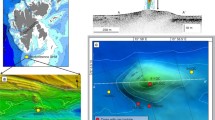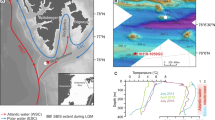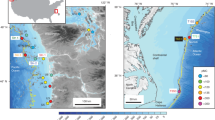Abstract
Numerous marine areas in SouthEast Asia are cold and deep enough to develop stable gas hydrates of greenhouse gases methane and carbon dioxide and of reducing agents such as hydrogen sulfide. In addition many of these deeps have low oxygen values below sill depths. Warming of such waters could:
(1) destabilize existing gas hydrates (clathrates) flashing them into gas and
(2) reduce the oxygen capacity of waters below the sill depth.
Outgassing could increase the buoyancy, producing upwelling of potentially noxious deep waters into the photic zone and even to the surface where the greenhouse gases would be added to the atmosphere. We plotted the depth (pressure) and temperatures of SouthEast Asian deep basins on a clathrate phase diagram to determine their suceptibility to outgassing and upwelling using a creditable global warming scenario. In general, most of the Indonesian basins are too cold or too deep for any pre-existing clathrates to be destabilized by perceived global warming. However, the Sulu Basin of the Philippines and the Halmahera Basin in Indonesian waters have sill depths in the pycnocline shoal enough and temperatures warm enough potentially to support outgassing and upwelling of basin waters, if water temperatures were raised. The presence of gas hydrates has not been demonstrated in these deeps. Although generally associated with high latitudes, clathrates have been identified in tropical waters off Central America. Accordingly, the proximity of the SouthEast Asian deeps to land and their low oxygen content suggest that tropical plant debris could accumulate and provide sufficient organic matter to generate methane and/or hydrogen sulfide clathrates. Local fisheries initially could be affected adversely by upwelling of anoxic or near anoxic waters into the photic zone. However, in the long term, the anoxic effects would dissipate and the nutrients brought up by the upwelling could increase primary productivity. A major adverse affect would be the introduction of methane into the atmosphere, as that gas has about 20 times the warming potential of carbon dioxide.
Similar content being viewed by others
References
Collett, T.S., Kvenvolden, K.A., and Magoon, L.B.: 1990, Applied Geochemistry, 5, 279–287.
Davy, H.: 1811, Roy. Soc. London Phil. Trans., 101, 1
Emerson, S., Jacobs, L., and Tebo, B.: 1983, In: C.S. Wong, E. Boyle, K.W. Bruland, J.D. Burton, and E.D. Goldberg, eds. Trace Metals in Sea Water. 579–608.
Francis, T.J.G. and Olivas, R.E.: 1993, EOS, 74, 316.
IPCC: 1992, J.T. Houghton and B. Bolin, eds. Intergovernment Panel on Climate Change, 1992 Supplement: Scientific Assessment of Climate Change. UNEP/WMO, Geneva.
Kvenvolden, K.A.: 1988a, Chem. Geol., 71, 41–51.
Kvenvolden, K.A.: 1988b, Global Biogeochemical Cycles, 2, 221–229.
Kvenvolden, K.A.: 1991, In: International Conference on the Role of the Polar Regions in Global Change, II, G. Weller, C.L. Wilson, and B.A.B. Severin, eds. 696–701.
Kvenvolden, K.A.: 1993, Rev. of Geophysics, 37, 173–187.
Macleod, M. K.: 1982, AAPG Bull., 66, 2649–2662.
Noaker, L.J. and Katz, D.L.: 1954, Pet. Trans., A.I.M.E., 201, 237–239.
Rhoads, D.C. and Morse, J.W.: 1971, Lethaia, 4, 413–428.
Richards, F.A.: 1965, In: J.P. Riley and G. Skirrow, eds., Chemical Oceanography. Academic, London, pp. 611–645.
Robinson, D.B. and Hutton, J.M.: 1967, J. of Canadian Petroleum Technology, 6, 6–9.
Shipley, T. H. and others: 1979, AAPG Bull, 63, 2204–2213.
Stachowitsch, M.: 1984, Marine Ecology, 5, 243–264.
Stoll, R. D, Ewing, J. and Bryan, G. M.: 1971, J. Geophys. Res., 74, 2090–2094.
Sverdrup, H. U., Johnson, M. W. and Fleming, R. H.: 1942, The Oceans, 1087pp
Tucholke, B. E., Bryan, G. M., and Ewing, J. W.: 1977, AAPG Bull, 61, 698–707.
van Riel, P. M.: 1934, Snellius Expedition in the eastern part of the Netherlands East Indies, 2, 63pp.
Weiss, R,F..: 1970, Deep-Sea Res., 17, 721–735.
White, R. S.: 1979, Earth.Planet.Sci.Ltrs., 42, 114–120
Wilde, P. and Berry, W.B.N: 1984, Palaeogeography, Palaeoclimatology, Palaeoecology, 48, 143–162.
Wilde, P., Quinby-Hunt, M.S., and Berry, W.B.N.: 1990, In: E.G. Kauffman and O.H. Walliser, eds., Extinction Events in Earth History 30, 85–98.
Author information
Authors and Affiliations
Rights and permissions
About this article
Cite this article
Wilde, P., Quinby-Hunt, M. Methane Clathrate Outgassing and Anoxic Expansion in Southeast Asian Deeps Due to Global Warming. Environ Monit Assess 44, 149–153 (1997). https://doi.org/10.1023/A:1005772120776
Issue Date:
DOI: https://doi.org/10.1023/A:1005772120776




